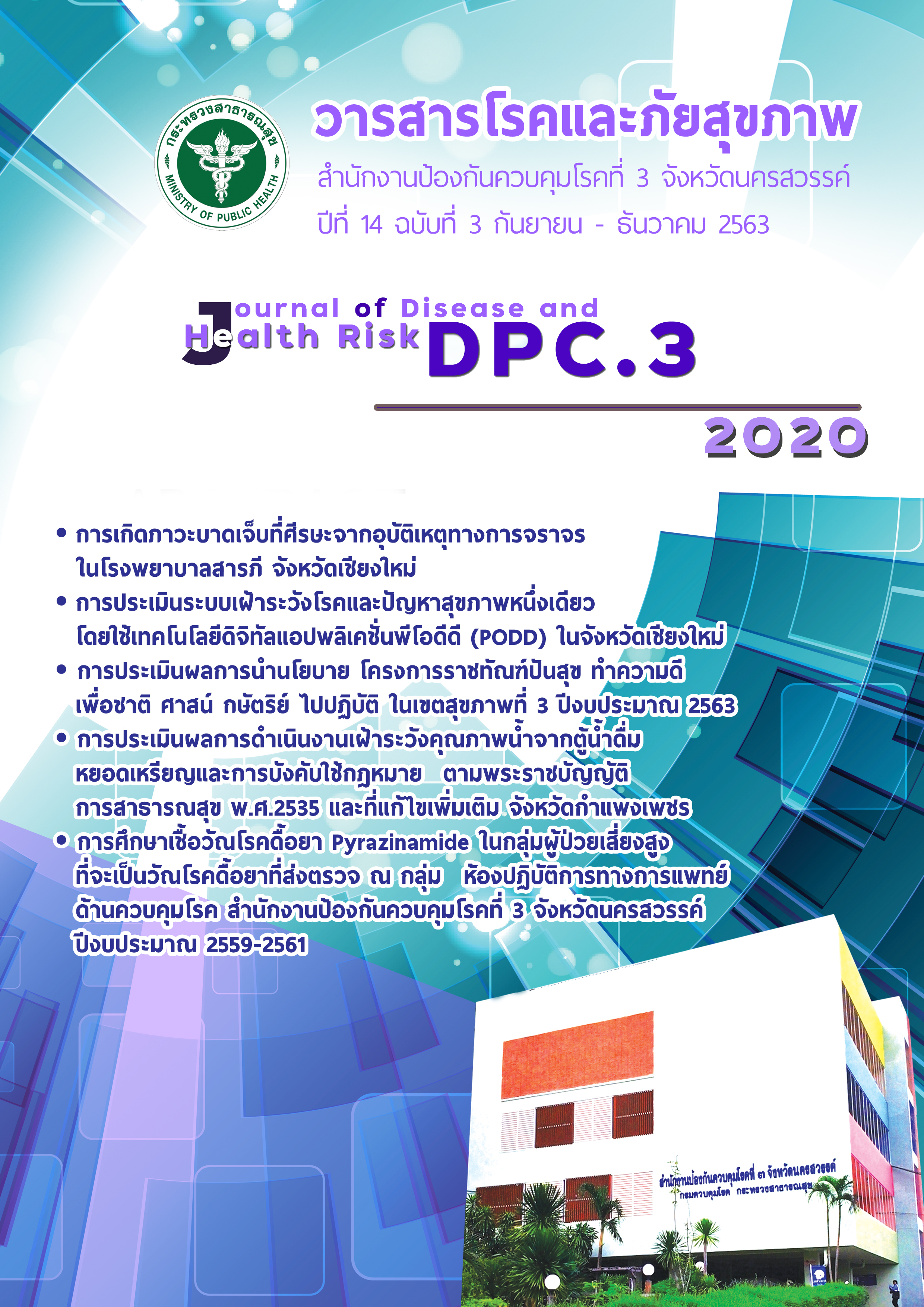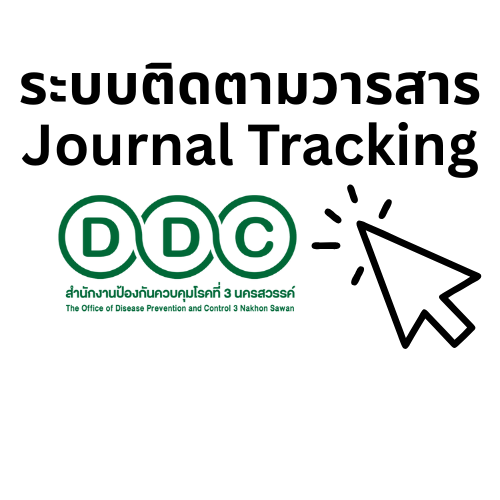การประเมินผลการดำเนินงานเฝ้าระวังคุณภาพน้ำจากตู้น้ำดื่มหยอดเหรียญ และการบังคับใช้กฎหมายตามพระราชบัญญัติการสาธารณสุข พ.ศ.2535 และที่แก้ไขเพิ่มเติม จังหวัดกำแพงเพชร
คำสำคัญ:
ตู้น้ำดื่มหยอดเหรียญ, การบังคับใช้กฎหมายตามพระราชบัญญัติ, การสาธารณสุข พ.ศ.2535 และที่แก้ไขเพิ่มเติมบทคัดย่อ
การศึกษาครั้งนี้ เป็นการศึกษาเชิงพรรณนา มีวัตถุประสงค์เพื่อประเมินผลการดำเนินงาน เฝ้าระวังคุณภาพน้ำจากตู้น้ำดื่มหยอดเหรียญและการบังคับใช้กฎหมายตามพระราชบัญญัติการสาธารณสุข พ.ศ. 2535 และที่แก้ไขเพิ่มเติม จังหวัดกำแพงเพชร ปี พ.ศ. 2562 โดยใช้รูปแบบการประเมินซิปโมเดล(CIPP Model) ของเดเนียล แอล สตัฟเฟิล (Danial L.Stufflebeam) ซึ่งประเมินผล 4 ด้าน คือ ปัจจัยแวดล้อมหรือบริบท (Context) ปัจจัยนำเข้า (Input) กระบวนการบริหารจัดการ(Process) และผลผลิต (Product) กลุ่มตัวอย่างมี 4 กลุ่ม ประกอบด้วย ผู้บริหารองค์กรปกครองส่วนท้องถิ่น จำนวน 89 คน ผู้บริหารองค์กรปกครองส่วนท้องถิ่น ที่ออกข้อบัญญัติท้องถิ่นเรื่อง การควบคุมการประกอบกิจการตู้น้ำหยอดเหรียญ จำนวน 4 คน ผู้ประกอบกิจการตู้น้ำดื่มหยอดเหรียญ จำนวน 38 คน และ ประชาชนผู้ใช้บริการตู้น้ำดื่มหยอดเหรียญ จำนวน 114 คน เก็บรวบรวมข้อมูล 2 แหล่ง คือ ข้อมูล ปฐมภูมิ (Primary data) เป็นข้อมูลเชิงปริมาณและเชิงคุณภาพ โดยแบบสอบถามและแบบสัมภาษณ์ และข้อมูลทุติยภูมิ (Secondary data) เก็บจากรายงานและเอกสารที่เกี่ยวข้อง ผลการศึกษา ปัจจัยแวดล้อมหรือบริบท(Context) พบว่า องค์กรปกครองส่วนท้องถิ่นในจังหวัดกำแพงเพชร มีการออกข้อบัญญัติท้องถิ่นควบคุมกิจการที่เป็นอันตรายต่อสุขภาพครบทุกประเภทกิจการตามประกาศกระทรวงสาธารณสุข จำนวน 62 แห่ง ร้อยละ 69.7 โดยออกข้อบัญญัติท้องถิ่นเรื่อง การควบคุมการประกอบกิจการตู้น้ำหยอดเหรียญ จำนวน 4 แห่ง ร้อยละ 4.5 จากการสำรวจสภาพแวดล้อมตู้น้ำดื่มหยอดเหรียญ ในพื้นที่องค์กรปกครองส่วนท้องถิ่น ที่ออกข้อบัญญัติท้องถิ่น เรื่อง การควบคุมการประกอบกิจการตู้น้ำหยอดเหรียญ พบว่า สถานที่ตั้งตู้น้ำส่วนใหญ่อยู่บริเวณหน้าบ้านพักอาศัย ร้อยละ 42.1 แหล่งน้ำดิบทั้งหมดเป็นน้ำประปา บริเวณที่ตั้งตู้น้ำดื่มหยอดเหรียญ พบว่า ตั้งอยู่ห่างไกลบริเวณที่มีฝุ่นมาก แหล่งระบายน้ำเสียและขยะมูลฝอย ร้อยละ 71.1 ไม่มีแหล่งแมลงและสัตว์พาหะนำโรค ร้อยละ 81.6 และบริเวณที่ตั้งไม่เฉอะแฉะ สกปรก มีการระบายน้ำที่ถูกสุขลักษณะ ร้อยละ 79.0 ซึ่งการดำเนินงานเฝ้าระวังคุณภาพน้ำจากตู้น้ำดื่มหยอดเหรียญของจังหวัดกำแพงเพชร มีความสอดคล้องกับยุทธศาสตร์ชาติ 20 ปี เป้าหมายการพัฒนาที่ยั่งยืน (SDGs) และแผนแม่บทการบริหารจัดการทรัพยากรน้ำ 20 ปี ตลอดจนนโยบายของกรมอนามัย กระทรวงสาธารณสุข ที่ส่งเสริมให้องค์กรปกครองส่วนท้องถิ่นพัฒนาระบบคุณภาพในการควบคุมการประกอบกิจการตู้น้ำหยอดเหรียญ(Environmental Health Accreditation : EHA) ให้ได้ตามเกณฑ์มาตรฐาน และจัดทำคำแนะนำคณะกรรมการสาธารณสุข เรื่องแนวทางการควบคุมการประกอบกิจการตู้น้ำหยอดเหรียญ พ.ศ.2553 เพื่อเป็นแนวทางให้ราชการส่วนท้องถิ่นในการออกข้อบัญญัติท้องถิ่น ด้านปัจจัยนำเข้า(Input) พบว่า องค์กรปกครองส่วนท้องถิ่น ที่ออกข้อบัญญัติท้องถิ่น เรื่อง การควบคุมการประกอบกิจการตู้น้ำหยอดเหรียญ จำนวน 4 แห่ง มีบุคลากรผู้รับผิดชอบงาน ทุกแห่ง แต่ไม่เพียงพอ ส่วนใหญ่ไม่ได้ตั้งงบประมาณและจัดเตรียมวัสดุอุปกรณ์ไว้สำหรับดำเนินการ ร้อยละ 75.0 ด้านกระบวนการบริหารจัดการ (Process) พบว่า มีแผนงานโครงการหรือกิจกรรมที่เกี่ยวข้อง ร้อยละ 50.0 มีโครงสร้างการแบ่งงานที่ชัดเจน ทุกแห่ง บุคลากรได้รับการพัฒนาเรื่องกฎหมายตามพระราชบัญญัติการสาธารณสุข พ.ศ. 2535 ร้อยละ 50 และมีการสื่อสารสาธารณะให้ผู้ประกอบการและประชาชนในพื้นที่ ร้อยละ 50 ด้านผลผลิต (Product) พบว่า มีการดำเนินการบังคับใช้กฎหมายฯ การสร้างการมีส่วนร่วม และควบคุมกำกับติดตาม ร้อยละ 75 ด้านการรับรู้และยอมรับกฎหมายฯ ของผู้ประกอบกิจการตู้น้ำดื่มหยอดเหรียญ พบว่า การรับรู้กฎหมายในภาพรวมอยู่ในระดับน้อย ร้อยละ 68.4 และการยอมรับกฎหมายในภาพรวมอยู่ในระดับมาก ร้อยละ 79.0 สำหรับพฤติกรรมของประชาชนที่ใช้บริการตู้น้ำดื่มหยอดเหรียญ พบว่า ใช้บริการตู้น้ำดื่มหยอดเหรียญ ทุกวัน ร้อยละ 31.6 และเหตุผลที่เลือกใช้บริการเพราะอยู่ใกล้ที่พัก ร้อยละ 24.0 ภาชนะที่นำไปบรรจุน้ำ คือขวดพลาสติก ขนาด 5 ลิตร ร้อยละ 40.4 มีการทำความสะอาดภาชนะที่ใช้บรรจุน้ำทุกครั้ง ร้อยละ 80.4 ด้วยวิธีกลั้วด้วยน้ำ ร้อยละ 65.8 ก่อนนำน้ำไปใช้ไม่มีการปรับปรุงคุณภาพน้ำ ร้อยละ 98.2 การตรวจคุณภาพน้ำจากตู้น้ำดื่มหยอดเหรียญ พบว่า น้ำประปาก่อนเข้าตู้น้ำดื่มหยอดเหรียญ มีค่าคลอรีนอิสระคงเหลือในน้ำไม่ผ่านเกณฑ์ ร้อยละ 89.5 และพบการปนเปื้อนโคลิฟอร์มแบคทีเรียในน้ำ ร้อยละ 39.5 ข้อเสนอแนะ การประกอบกิจการตู้น้ำดื่มหยอดเหรียญ เป็นกิจการที่เป็นอันตรายต่อสุขภาพ ที่อาจส่งผลกระทบต่อสุขภาพอนามัยของประชาชน ดังนั้น องค์กรปกครองส่วนท้องถิ่น ซึ่งมีอำนาจในการออกข้อบัญญัติท้องถิ่น ควรดำเนินการออกข้อบัญญัติท้องถิ่น เรื่อง การควบคุมการประกอบกิจการตู้น้ำหยอดเหรียญ ตามพระราชบัญญัติการสาธารณสุข พ.ศ. 2535 และที่แก้ไขเพิ่มเติม เพื่อควบคุมกำกับดูแลและเฝ้าระวังการประกอบกิจการตู้น้ำดื่มหยอดเหรียญในเขตพื้นที่ที่รับผิดชอบ ให้เป็นไปตามที่กฎหมายกำหนด และประชาสัมพันธ์ให้ความรู้แก่ประชาชนผู้บริโภค ในการเลือกใช้บริการตู้น้ำดื่มหยอดเหรียญ ที่ถูกสุขลักษณะ มีเครื่องหมายรับรองมาตรฐาน ตลอดจนมีพฤติกรรมการใช้บริการตู้น้ำดื่มหยอดเหรียญ ที่ถูกต้องเหมาะสม อีกทั้งหน่วยงานภาครัฐที่เกี่ยวข้อง ต้องดำเนินการขับเคลื่อนให้องค์กรปกครองส่วนท้องถิ่น ออกข้อบัญญัติท้องถิ่นและการบังคับใช้กฎหมายให้เหมาะสมตามบริบทของพื้นที่ โดยผ่านกลไกคณะกรรมการสาธารณสุขจังหวัด
เอกสารอ้างอิง
กรมอนามัย กระทรวงสาธารณสุข.คู่มือการควบคุมและเฝ้ าระวังคุณภาพน้ำดื่มในโรงเรียน.พิมพ์ครั้งที่ 1.บริษัท เอ็นซี คอนเซ็ปต์ จำกัด; 2561.
วริศรา ปีอาทิตย์ และอลงกรณ์ วงศ์หมั่น. คุณภาพน้ำดื่มจากเครื่องผลิตน้ำดื่มหยอดเหรียญวิทยานิพนธ์วิทยาศาสตรบัณฑิตทรัพยากรธรรมชาติและสิ่งแวดล้อม มหาวิทยาลัยนเรศวร,จังหวัดพิษณุโลก; 2557.
สำนักสารนิเทศ สำนักงานปลัดกระทรวงสาธารณสุข.คุณภาพน้ำาจากตู้น้ำดื่มหยอดเหรียญผ่านเกณฑ์เพิ่มขึ้น.[อินเตอร์เน็ต].2562.[เข้าถึงเมื่อ 11 มิถุนายน 2563]
ชยันตร์ธร ปทุมานนท์.ระบาดวิทยาการแพทย์.พิมพ์ครั้งที่1 พ.ศ.2541.
รัตนะ บัวสนธ์.รูปแบบการประเมิน CIPP และ CIPPIEST มโนทัศน์ที่คลาดเคลื่อนและถูกต้องในการใช้CIPP และ CIPPIEST Evaluation Models : Mis-taken and Precise Concepts of Applications.วารสารศิลปากรศึกษาศาสตร์วิจัย. ปีที่ 5 ฉบับที่ 2 (กรกฎาคม–ธันวาคม 2556); 2556.
นรา ระวาดชัย. ปัจจัยที่มีผลต่อคุณภาพน้ำดื่มจากตู้หยอดเหรียญอัตโนมัติ. วิทยานิพนธ์ปริญญาสาธารณสุขศาสตรมหาบัณฑิต มหาวิทยาลัยขอนแก่น; 2555.
ลีลานุช สุเทพารักษ์. การประเมินคุณภาพน้ำจากตู้นน้ำดื่มหยอดเหรียญ. กรมอนามัย กระทรวงสาธารณสุข.ถ่ายเอกสาร; 2558.
Best, John W.Research in Education. 3rd ed. Englewood Cliffs, New Jersey: Prentice Hall, Inc 1997; 174.
พิชิต ฤทธิ์จรูญ.หลักการวัดและประเมินผลการศึกษา. พิมพครั้งที่ 3. กรุงเทพฯ: เฮ้าสออฟ เคอร์มีสท์; 2548.
Bloom et al. การแบ่งระดับความรู้โดยเกณฑ์ของบลูม.1968. [เข้าถึงเมื่อ 11 มิถุนายน 2563] เข้าถึงได้จาก : https:// www.google.co.th/search
นวรัตน์ สุวรรณผ่อง และฉวีวรรณ บุญสุยา.การประเมินผลและการเขียนแผนงาน/โครงการด้านสาธารณสุข.พิมพ์ครั้งที่ 1.กรุงเทพฯ: คณะกรรมการพัฒนาองค์การเอกชนด้านเอดส์ (กพอ.); 2542.
ดาวน์โหลด
เผยแพร่แล้ว
รูปแบบการอ้างอิง
ฉบับ
ประเภทบทความ
สัญญาอนุญาต
ลิขสิทธิ์ (c) 2020 วารสารโรคและภัยสุขภาพ สำนักงานป้องกันควบคุมโรคที่ 3 จังหวัดนครสวรรค์

อนุญาตภายใต้เงื่อนไข Creative Commons Attribution-NonCommercial-NoDerivatives 4.0 International License.
ประกาศเกี่ยวกับลิขสิทธิ์
|
บทความที่เผยแพร่ในวารสารโรคและภัยสุขภาพสำนักงานป้องกันควบคุมโรคที่ 3 จังหวัดนครสวรรค์ ถือว่าเป็นผลงานทางวิชาการหรือการวิจัย และวิเคราะห์ ตลอดจนเป็นความเห็นส่วนตัวของผู้เขียน ไม่ใช่ความเห็นของสำนักงานป้องกันควบคุมโรคที่ 3 จังหวัดนครสวรรค์ หรือกองบรรณาธิการแต่ประการใด ผู้เขียนต้องรับผิดชอบต่อบทความของตน |
นโยบายความเป็นส่วนตัว
|
ชื่อและที่อยู่ อีเมล์ ที่ระบุในวารสารโรคและภัยสุขภาพสำนักงานป้องกันควบคุมโรคที่ 3 จังหวัดนครสวรรค์ จะใช้เพื่อระบุตามวัตถุประสงค์ของวารสารเท่านั้น และจะไม่นำไปใช้สำหรับวัตถุประสงค์อื่น หรือต่อบุคคลอื่น |









